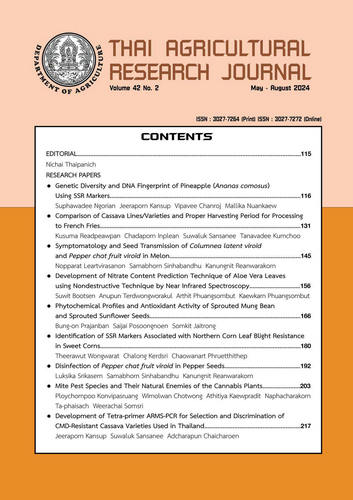Symptomatology and Seed Transmission of Columnea latent viroid and Pepper chat fruit viroid in Melon
DOI:
https://doi.org/10.14456/thaidoa-agres.2024.12Keywords:
Columnea latent viroid, Pepper chat fruit viroid, seed transmission, cucurbit, melonAbstract
Columnea latent viroid (CLVd) and Pepper chat fruit viroid (PCFVd) are important quarantine pests, causing damage to agricultural products, especially tomato, potato, pepper, and some cucurbits. This work was to study the symptoms and seed transmission of CLVd and PCFVd in melon to provide information for observing abnormal symptoms that might occur in melon growing fields. Melon cultivars were mechanically inoculated at the seedling stage, self-pollinated and seeds harvested for seed transmission investigation. It was found that CLVd and PCFVd could cause disease in melons with 25 – 86 and 0 – 100% infection rates, respectively. All four cultivars of CLVd-infected melon displayed symptoms at 8 weeks post inoculation (wpi) with stunting, shorten internodes, small and stacked leaves, small male flowers with abnormal petals, and abundance of non-developed male and female flowers. While two of three tested cultivars of PCFVd-inoculated melon expressed symptoms at 6 wpi with apical shoot stunting, and fully clustering flowers without of fruit setting. For grow out test in a greenhouse, seed transmission rate of CLVd-infected melon was 0.5% in Melon-2 cultivar only. However, PCFVd seed transmission was not found in all the PCFVd-infected melon cultivars in this study. The current findings of viroid melon diseases could be useful for routine disease observation and immediate eradication of CLVd and PCFVd infected plants to reduce disease dissemination and viroid seed contamination especially in CLVd.
References
กนกมณี ตันสุวรรณ และคนึงนิตย์ เหรียญวรากร. 2561 การถ่ายทอดเชื้อ Columnea latent viroid ผ่านทางเมล็ดของแตงกวา. วารสารวิชาการเกษตร. 36(2): 130-140.
กรมส่งเสริมการเกษตร. 2562. เมล่อนญี่ปุ่น - สารสนเทศ ส่งเสริมการเกษตร. แหล่งที่มา: https://www. http://www.agriinfo.doae.go.th/year63/plant/rortor/veget/.pdf/ สืบค้น: 10 กรกฎาคม 2566.
ปริเชษฐ์ ตั้งกาญจนภาสน์. 2548. การตรวจสอบเชื้อไวรอยด์ในแปลงผลิตเมล็ดพันธุ์มะเขือเทศในเขตภาคตะวันออกเฉียงเหนือของประเทศไทย. วิทยานิพนธ์ปริญญาโท. มหาวิทยาลัยเกษตรศาสตร์. กรุงเทพฯ. 85 หน้า.
ปริเชษฐ์ ตั้งกาญจนภาสน์ คนึงนิตย์ เหรียญวรากร และวิภา เกิดพิพัฒน์. 2556ก. เชื้อ Columnea latent viroid (CLVd) สายพันธุ์ใหม่ที่ก่อให้เกิดอาการรุนแรงในมะอึก (Solanum stramonifolium Jacq.). วารสารวิชาการเกษตร. 31(1): 53-68.
ปริเชษฐ์ ตั้งกาญจนภาสน์ คนึงนิตย์ เหรียญวรากร และวิภา เกิดพิพัฒน์. 2556ข. การตรวจวินิจฉัยเชื้อ Columnea latent viroid (CLVd) และ Pepper chat fruit viroid (PCFVd) ในพืชตระกูล Solanaceae. วารสารวิชาการเกษตร. 31(2): 108-122.
ศศิประภา มาราช. 2551. โคลนก่อโรคของเชื้อ Columnea latent viroid และผลกระทบต่อมะเขือเทศพันธุ์การค้า. วิทยานิพนธ์ปริญญาโท. มหาวิทยาลัยเกษตรศาสตร์. กรุงเทพฯ. 86 หน้า.
ษมาภร ภูวิธกรณ์ จิราพร ปอสูงเนิน สุภาพร กลิ่นคง และคนึงนิตย์ เหรียญวรากร. 2562. การเข้าทำลายและการถ่ายทอดทางเมล็ดของ Columnea latent viroid ในพริก. วารสารเกษตร. 35(1): 101-111.
สำนักควบคุมพืชและวัสดุการเกษตร. 2565. ข้อมูลการนำเข้าและส่งออกเมล็ดพันธุ์ควบคุมเพื่อการค้าปี 2565. แหล่งที่มา: https://www.doa.go.th/ard/?page_id=1443. สืบค้น: 23 มีนาคม 2566.
Bhuvitarkorn, S and K. Reanwarakorn. 2019. Pollen and seed transmission of Columnea latent viroid in eggplants. European Journal of Plant Pathology. 154(4): 1067-1075.
Chambers, G.A., A.M. Seyb, J. Mackie, F.E. Constable, B.C. Rodoni, D. Letham, K. Davis and M.J. Gibbs. 2013. First report of Pepper chat fruit viroid in traded tomato seed, an interception by Australian Biosecurity. Plant Disease. 97(10): 1386.
Chen, F., P. Dahal and K. J. Bradford. 2001. Two tomato expansion genes show divergent expression and localization in embryos during seed development and germination. Plant Physiology. 127(3): 928-936.
Constable, F., G. Chambers, L. Penrose, A. Daly, J. Mackie, K. Davis, B. Rodoni and M. Gibbs. 2019. Viroid-infected tomato and capsicum seed shipments to Australia. Viruses. 11(2): 98.
Dall, D., L. Penrose, A. Daly, F. Constable and M. Gibbs. 2019. Prevalences of pospiviroid contamination in large seed lots of tomato and capsicum, and related seed testing considerations. Viruses. 11: 1034.
EPPO. 2023. EPPO Global Database. Available at: https://gd.eppo.int. Accessed: July 10, 2023.
Flores, R., B. Navarro, P. Serra and F. Di Serio. 2022. A scenario for the emergence of protoviroids in the RNA world and for their further evolution into viroids and viroid-like RNAs by modular recombinations and mutations. Virus Evolution. 8(1): veab107.
Flores, R., J.W. Randles, M. Bar-Joseph and T.O. Diener. 1998. A proposed scheme for viroid classification and nomenclature. Archives of Virology. 143: 623-629.
Legrand, P. 2015. Biological assays for plant viruses and other graft-transmissible pathogens diagnoses: a review. EPPO Bulletin. 45: 240-251.
Lemmetty, A., A. W. Werkman and M. Soukainen. 2011. First report of Hop stunt viroid in greenhouse cucumber in Finland. Plant Disease. 95(5): 615.
Matsushita, Y., H. Yanagisawa and T. Sano. 2018. Vertical and horizontal transmission of pospiviroids. Viruses. 10(12): 706.
Matsushita, Y. and S. Tsuda. 2016. Seed transmission of Potato spindle tuber viroid, Tomato chlorotic dwarf viroid, Tomato apical stunt viroid and Columnea latent viroid in horticultural plants. European Journal of Plant Pathology. 145: 1007-1011.
Navarro, B., R. Flores and F. Di Serio. 2021. Advances in viroid-host interactions. Annual Review of Virology. 8(1): 305-325.
Nie, X and R.P. Singh. 2017. Viroid detection and identification by bioassay. pp. 347-356. In: Viroids and Satellites. Academic Press.
Reanwarakorn, K., S. Klinkong and J. Porsoongnurn. 2011. First report of natural infection of Pepper chat fruit viroid in tomato plants in Thailand. New Disease Reports. 24(6): 2044-0588.
Škorić, D. 2017. Viroid biology. pp. 53-61. In: Viroids and Satellites. Academic Press.
Van Dorst, H.J.M and D. Peters. 1974. Some biological observations on pale fruit, a viroid-incited disease of cucumber. Netherlands Journal of Plant Pathology. 80: 85-96.
Verhoeven, J. T., C.C. Jansen, J. W. Roenhorst, R. Flores and M. de la Peña. 2009. Pepper chat fruit viroid: biological and molecular properties of a proposed new species of the genus Pospiviroid. Virus Research. 144(1-2): 209-214.
Yaguchi, S and T. Takahashi. 1984. Response of cucumber cultivars and other cucurbitaceous species to Infection by Hop Stunt Viroid. Journal of Phytopathology. 109(1): 21-31.
Yanagisawa, H. and Y. Matsushita. 2017. Host ranges and seed transmission of Tomato planta macho viroid and Pepper chat fruit viroid. European Journal of Plant Pathology. 149: 211-217.
Zhang, S and D. Groth-Helms. 2024. Viroid diseases of tomato. pp. 379-385. In: Viral Diseases of Field and Horticultural Crops. Academic Press.
Downloads
Published
How to Cite
Issue
Section
License
Copyright (c) 2024 Thai Agricultural Research Journal

This work is licensed under a Creative Commons Attribution-NonCommercial-NoDerivatives 4.0 International License.
Thai Agricultural Research Journal



